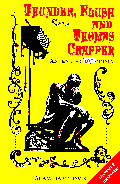Thunder, Flush and Thomas Crapper: D
^UP^ to Thunder, Flush and Thomas Crapper index.
Chapters: A B C D E F G H I J K L M N O P R S T U V W Y Z

Extracts from Adam Hart-Davis's book.
(Buy the book from Micheal O'Mara Books, ISBN 1-85479-250-4, hardback 1-85479-245-8, or in the US, ISBN 1570760810.)
- Desert Lavatories
-
 Oil prospectors in the deserts of the Middle East and Australia have left
on the landscape their own permanent monuments in tasteful porcelain.
Oil prospectors in the deserts of the Middle East and Australia have left
on the landscape their own permanent monuments in tasteful porcelain.
A single prospector just goes over the dunes with his 'dunny-roll' (in Australia) and perhaps scrapes a hole with a heel. When a team is gathered in one place they build a lavatory hut. First cut out one end of a 45-gallon oil drum and punch a few drain holes in the other end. Dig a hole and bury it so that the cut-out end is level with the ground. Across the top, put a platform of marine plywood, or metal if available, with a nine-inch hole in it. Place a normal porcelain lavatory with its outlet pipe down the hole into the drum, and set the loo in concrete. Then put a corrugated-iron or similar hut around it to make a privy.
The lavatory is used as usual, and flushed either with a bucket of water from a separate water butt outside (often another 45-gallon oil drum), or from a makeshift overhead cistern. Lime may be added to the water. The water trap in the s-bend keeps the smell and the insects more or less at bay.
When the prospectors move on they often take the hut with them, and within a few years the wind and the blowing sand erase all other traces of human occupation, except for the porcelain lavatory, immune to erosion, standing proud in the desert sand.
- disease
-
The greatest advance in human health has come as
a direct result of keeping excrement out of the drinking water.
Control of malaria by DDT and of bacterial infections by
penicillin have had nothing like the same impact as separating
the sewage from the fresh water supply.
In the 1830s the death-rate among children under five in England was 24 per cent (24%) in the country and 48 per cent (48%) in town. In other words, only half the children in towns lived to be five years old. They died from typhoid, paratyphoid, cholera, diarrhea, dysentry, and gastro-enteritis. Queen Victoria's consort, Prince Albert, died of typhoid in 1861.
In 1985 child mortality was about one per cent (1%) in the UK, but still frighteningly high in countries without proper sanitation; 20 per cent (20%) in Bangladesh, 19 per cent (19%) in Haiti, 21 per cent (21%) in Nepal, 31 per cent (31%) in Sierra Leone.
The leading weapon in the successful fight against disease has been the lavatory, for effective lavatories are the first stage in separating sewage from what we eat and drink. Wash your hands after going, and you are well on your way to avoiding disease.
See also hygiene.
- Duchamp
-
The celebrated artist Marcel Duchamp (1887--1968)
had a curious vision of what was artistic. He
sometimes put on show unusual manufactured objects as
sculptures; he called them "ready-mades". At an exhibition in
New York City in 1917 he exhibited a urinal, and called it
"fontaine". See also Sense.
Text extracts from "Thunder, Flush and Thomas Crapper" copyright (c) Adam Hart-Davis 1997. Web extracts first published 2007-07-18, updated ✎2018-02-25
Images available from the DHD Multimedia Gallery.
Site content copyright (c) Damon Hart-Davis 1997--2018 unless otherwise stated.
Hosted by ExNet.